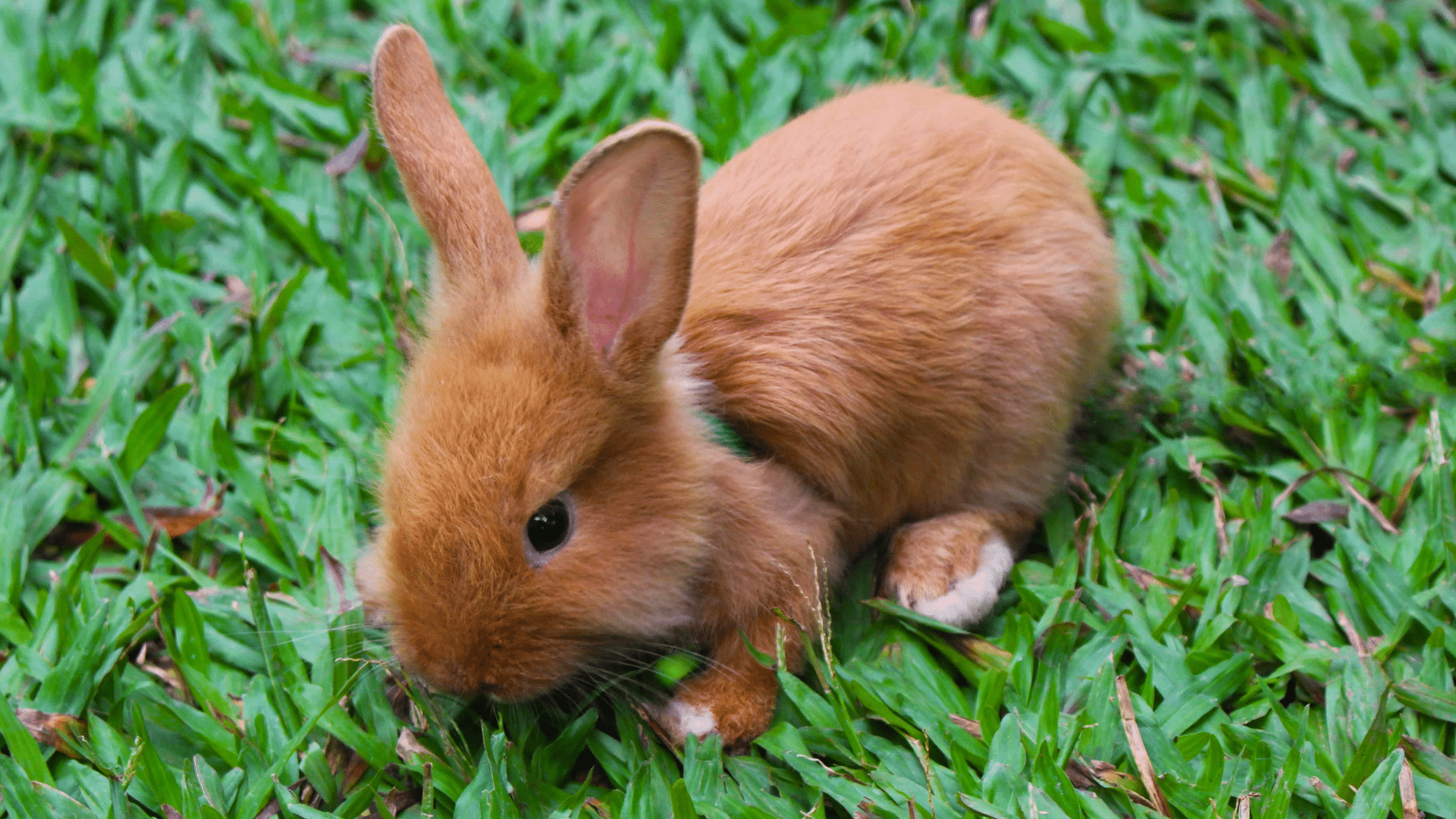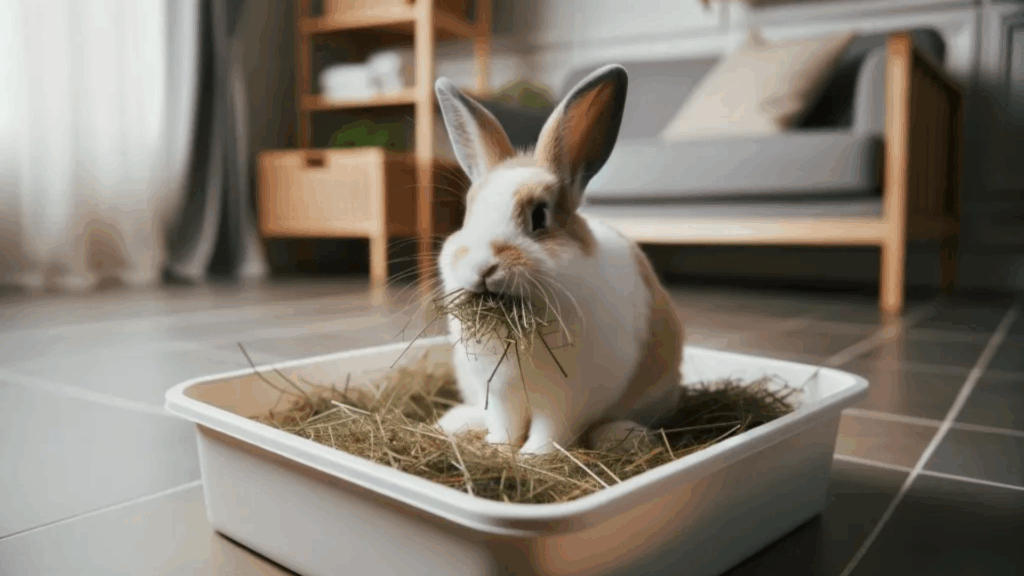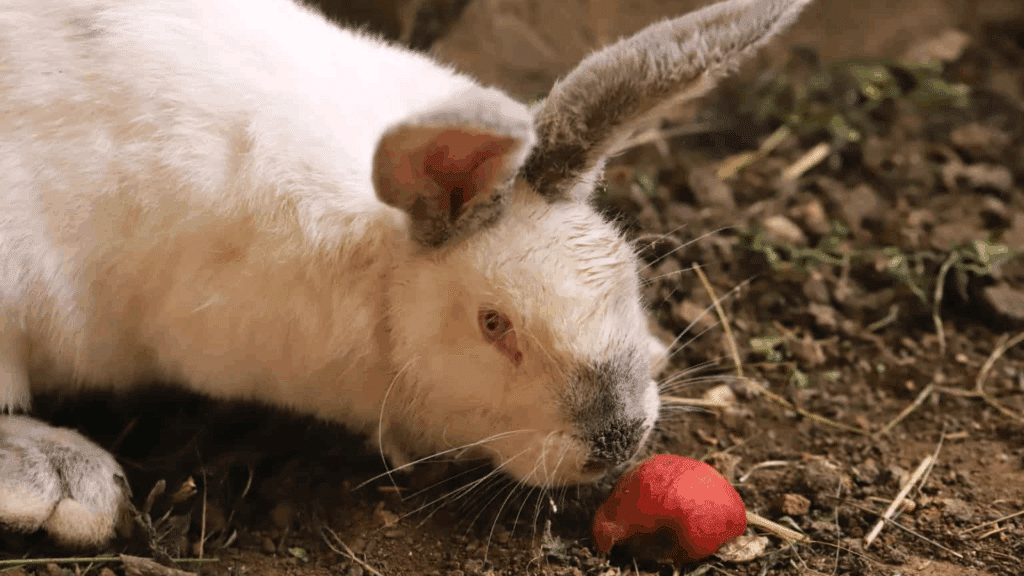How to litter train a rabbit at home is one of the most helpful things you can learn as a pet owner. It keeps your space clean, reduces odor, and makes daily care much easier.
Many people think it’s hard to train a rabbit, but with the right setup and patience, it’s simple and rewarding.
In this guide, you’ll learn:
- What you need to start litter training
- How to pick the right litter box and safe litter
- Step-by-step tips to teach your rabbit where to go
By the end, you’ll know exactly how to create a clean, stress-free space for your rabbit. Litter training isn’t just about tidiness; it’s about helping your bunny feel safe and at home.
What You Need to Litter Train a Rabbit?
Before you start litter training, it helps to have a few simple items ready. These make the process smoother for both you and your rabbit. This is what I use and recommend:
- Litter Box: Choose a box that’s big enough for your rabbit to move around in. I find open, low-sided boxes work best since they’re easy to enter and clean.
- Safe Litter: Go for paper-based or wood-pellet litter. It’s safe if your rabbit chews on it and does a good job absorbing odor and moisture.
- Cleaning Supplies: Keep pet-safe cleaners or a vinegar-water mix nearby. You’ll need them to clean up accidents and keep the litter box fresh.
- Treats: Use small treats to reward your rabbit when it uses the litter box. It helps your bunny connect good behavior with a positive outcome.
Choosing the Right Litter Box for Your Rabbit
When it comes to choosing the right litter box for your rabbit, size and comfort matter most. I’ve learned that the box should be large enough for your rabbit to turn around and sit comfortably.
For small rabbits, a medium-sized cat litter box works fine, while large breeds often do better with storage bins or plastic trays.
The shape doesn’t have to be fancy; rectangular boxes are easy to clean and fit neatly in corners.
I prefer open boxes because rabbits don’t like tight or covered spaces, and open ones make it easier to see when cleaning is needed. Placement also makes a big difference.
Put the box in a quiet corner of your rabbit’s play area, somewhere your bunny already tends to go.
Keeping the box in the same spot helps your rabbit learn where to go faster.
How to Litter Train a Rabbit Step-By-Step?

Before you start the training steps, it helps to know what to expect. These simple steps show exactly how I litter train my rabbit, from setting up the box to rewarding good habits, so you can follow along and see real progress.
1. Introduce the Litter Box
Start by letting your rabbit get used to the litter box. I place it in the area where my rabbit spends most of the time. Let your bunny sniff and explore it freely.
You can put a few droppings or hay in the box to give a scent cue. Never force your rabbit inside, as that can make them anxious.
Instead, let them hop in on their own. Once they do, reward them with a small treat to build a positive connection.
2. Place the Box in the Right Spot
Rabbits usually pick one corner for their bathroom habits. I watch mine for a day or two to find that favorite spot. Once you notice it, place the litter box there.
Keep it in a quiet area, away from their food and water, but still easy to reach.
If your rabbit has a large space, add another box in another corner to make it more convenient. Consistency helps them learn faster.
3. Use Hay to Attract Your Rabbit
Rabbits like to eat while they use the bathroom, which might sound odd, but really helps with training.
I place a pile of hay either inside one side of the litter box or right next to it. Fresh hay encourages your rabbit to sit in the box longer, which leads to more success.
Just make sure to keep it clean and change it daily. Soon, your rabbit will connect the box with both comfort and routine.
4. Reward Good Behavior
Every time your rabbit uses the litter box correctly, give them a small treat or gentle praise. I use small pieces of fruit or rabbit-safe snacks.
Positive reinforcement makes learning easier and builds trust between you and your rabbit.
Avoid punishment for accidents; it only causes stress. Stay calm, clean up the mess, and keep reinforcing the right behavior.
With time and patience, your rabbit will start using the litter box on its own.
What Other Rabbit Owners Say About Litter Training?

In one Reddit thread, a new rabbit owner shared how her 3-month-old bunny peed in the litter box but left droppings everywhere else. Many experienced owners jumped in with reassurance and practical advice.
The most common tip was patience; young rabbits are still learning and often scatter poop to mark territory.
Several users suggested spaying or neutering, since hormones can affect litter habits.
Others mentioned that placing hay directly in or beside the litter box helps rabbits stay in the box longer and associate it with comfort.
Cleaning was another key point. Owners advised using a white vinegar and water mix instead of soap, since rabbits may return to spots that still smell of urine.
Some shared that it took a few months before their rabbits fully caught on, proving that time, consistency, and calm persistence work best.
Benefits of Rabbit Litter Training
Litter training isn’t just about keeping things tidy; it helps you and your rabbit live more comfortably together. Here’s how it makes a real difference over time:
- Cleaner Home: Litter training keeps messes in one place, making daily cleanup quick and easy.
- Better Health for Your Rabbit: A clean litter area helps prevent infections and keeps your rabbit’s feet dry and healthy.
- Stronger Bond: Caring for your rabbit in a calm, routine way builds trust and comfort between you both.
- Less Odor: Using the right litter and cleaning regularly keeps your home smelling fresh.
- Long-Term Convenience: Once trained, your rabbit will stick to good habits, saving you time and effort every day.
Setting up the Litter Area at Home
When setting up the litter area at home, focus on making it calm, consistent, and easy to reach. I always choose a quiet corner away from noise, kids, or other pets so my rabbit feels safe.
A low-traffic area helps your bunny relax and use the litter box without stress.
Keep the food bowl and hay near the box, since rabbits like to eat and go at the same time. The floor should be non-slippery and easy to clean in case of accidents.
Make sure the litter box stays in the same spot once your rabbit starts using it, as consistency builds good habits.
Add a small mat under the box to catch any scattered litter. This simple setup keeps your home tidy and helps your rabbit adjust faster.
Tips to Encourage Good Litter Habits
Litter training takes patience and small daily efforts. These simple tips can help you and your rabbit build consistent habits faster.
- Reward good behavior: Give a small treat or soft praise every time your rabbit uses the box correctly.
- Keep it clean: Scoop daily and change the litter often to maintain a fresh, inviting area.
- Be patient: Progress can take days or weeks, so stay calm and consistent.
- Use consistent placement: Keep the litter box in one spot to help your rabbit remember where to go.
- Watch for cues: When your rabbit sniffs or circles, gently guide them toward the box.
- Make it comfortable: Use soft, safe litter and a box that’s easy to hop into.
- Limit space at first: Start training in a smaller area before giving your rabbit full access to the room.
- Add extra boxes: If your rabbit roams freely, place a few boxes in different corners.
- Use hay as encouragement: Rabbits like to munch while they go. Putting hay near or inside the box helps.
- Avoid strong scents: Skip air fresheners or scented litter, as rabbits prefer mild, natural smells.
How to Handle Accidents During Training?

Accidents are a normal part of litter training, so staying calm is key. I never scold my rabbit for missing the box, it only causes fear and slows progress.
Instead, I gently clean the spot using a vinegar and water mix to remove odor so my rabbit doesn’t return to the same area.
If there are droppings, I place a few inside the litter box to remind them where to go next time.
Positive reinforcement works best, so I reward my rabbit when it uses the box correctly.
Keeping the box clean and in the same spot also helps avoid confusion. If accidents keep happening, I check for things like box placement, litter type, or cleanliness.
With patience and consistency, rabbits learn that the litter box is the right place every time.
Common Litter Training Mistakes to Avoid
Even with the best effort, small mistakes can slow your rabbit’s progress. Here are some common ones I’ve seen, and how you can fix them easily:
- Using scented litter: Rabbits dislike strong smells. Choose unscented, paper-based litter instead.
- Moving the litter box too often: Frequent changes confuse your rabbit. Keep the box in one spot for consistency.
- Punishing accidents: Rabbits don’t understand punishment. Stay calm, clean the area, and guide them back to the box.
- Not cleaning often enough: Dirty boxes make rabbits avoid them. Scoop daily and replace litter every few days.
- Using slippery flooring around the box: Rabbits may slip and avoid that area. Add a mat or rug for traction.
- Starting in a large space: Begin training in a smaller area so your rabbit learns faster and stays focused.
Conclusion
Litter training a rabbit takes time, patience, and steady effort, but the results are worth every bit of it. Once your rabbit learns where to go, your home becomes cleaner, fresher, and easier to maintain.
More importantly, your rabbit feels safe and comfortable in its space.
Remember, progress may be slow at first, but consistency always pays off. Stay calm, keep up with cleaning, and reward good behavior.
Over time, your rabbit will form lasting habits that make daily care simple.
If you’re ready to start, gather your supplies and set up your rabbit’s litter area today, and you’ll see just how rewarding this process can be for both you and your pet.








